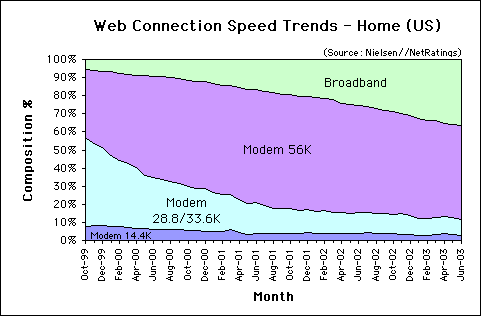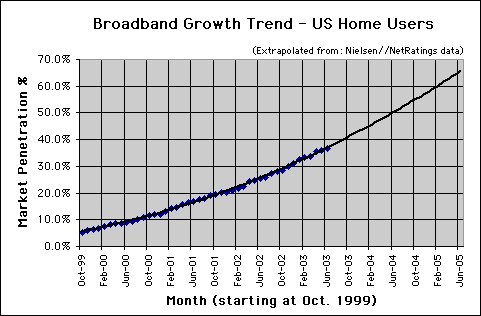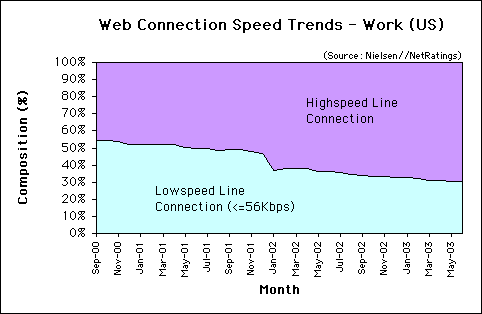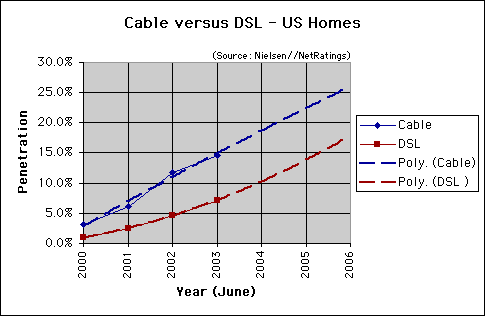Cable has 67% to 105% more users than DSL in the US, according to two recent surveys. Overall, broadband grew by 0.83 percentage points in June, with 36.7% of wired US users enjoying a high-speed connection.
The charts and tables below, derived from Nielsen//NetRatings and Ipsos-Insight data, show trends in connection speeds to the Internet in the US.
Home Connectivity in the US
As of June 2003, most users in the US connect to the Internet using dial-up modems of 56Kbps or less. 51.4% use 56Kbps modems, 9% use 28/33.3Kbps, and 2.9% use 14.4Kbps modems. In total, 63.3% of home users in the US connect to the Internet at 56Kbps or less (see Figure 1).
Web Connection Speed Trends – Home Users (US)
Figure 1: Web Connection Speed Trends – Home Users (US)
Source: Nielsen//NetRatings
Broadband Growth in the US
Broadband penetration in US homes increased by 0.83 percentage points in June. As of June 2003 broadband penetration was at 36.7%, up from 35.87% in May. This is higher than the average increase in broadband of 0.72 percentage points per month from October 1999 to May 2003. Extrapolating the data provided by Nielsen//NetRatings, broadband share in the US should exceed 50% by June of 2004 (see Figure 2).
Broadband Connection Speed Trend – Home Users (US)
Figure 2: Broadband Connection Speed Trend – Home Users (US)
Extrapolated from Nielsen//NetRatings data
Work Connectivity
Most workers in the US enjoy high-speed connections to the Internet. Most use a high-speed line such as a T1 connection, and share bandwidth between computers connected to a network. The speed of each connection decreases as more employees hook up to the LAN. As of June of 2003, of those connected to the Internet, 69.8% of US users at work enjoy a high-speed connection, up slightly from 69.7% in May. 30.2% connect from work at 56Kbps or less (see Figure 3).
Web Connection Speed Trends – Work Users (US)
Figure 3: Web Connection Speed Trends – Work Users (US)
Source: Nielsen//NetRatings
Cable versus DSL
Ipsos-Insight found in a May 2003 survey of 1,000 US adults that 40% had broadband while 59% had a dial-up connection. Of those with broadband, 25% had a cable connection while 15% had a DSL connection. Confirming this trend, Nielsen//NetRatings found that cable has over twice the penetration (14.6%) of DSL (7.1%) in the US as of June 2003. Extrapolating the data provided by Nielsen//NetRatings, cable share in the US should exceed 25% by summer 2006 while DSL should exceed 10% by June 2004 (see Figure 4).
Cable and DSL Growth Trend – Home Users (US)
Figure 4: Cable versus DSL Growth Trend – Home Users (US)
Extrapolated from Nielsen//NetRatings data
Cable and DSL Growth as a Percentage of US Home Users
| Connection type | Jun-00 | Jun-01 | Jun-02 | Jun-03 |
|---|---|---|---|---|
| Cable | 3.1% | 6.2% | 11.7% | 14.6% |
| DSL | 1.0% | 2.4% | 4.7% | 7.1% |
Source: Nielsen//NetRatings
Cable versus DSL
| Connection type | Penetration |
|---|---|
| Dial-up | 59% |
| Cable | 25% |
| DSL | 15% |
| Other | 1% |
Source: Ipsos-Insight
The Bandwidth Report is featured monthly on URLwire – news of useful and unique web content since 1994.




